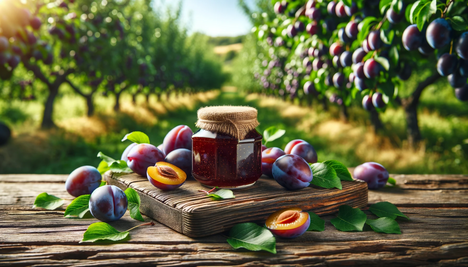Plum jam

The benefits of prune puree for dogs
Prune puree has several benefits for your dog's health. It contains many vitamins, minerals and antioxidants that boost the immune system, strengthen the muscles and support the bones and teeth. The most important nutrients in prune puree include
- Vitamin A: Good for your dog's eyes, skin and coat.
- B vitamins: Boost your dog's metabolism, nerve function and blood formation.
- Vitamin C: Protects against infections, inflammation and oxidative stress.
- Vitamin E: Acts as an antioxidant and protects cells from damage.
- Potassium: Regulates your dog's fluid and electrolyte balance.
- Calcium: Important for your dog's bone and dental health.
- Magnesium: Prevents cramps and is good for your dog's muscles.
- Iron: Supports the formation of your dog's red blood cells.
Prune puree also has a digestive effect. It can help with constipation as it contains fiber and sorbitol, which stimulate bowel movements. It can also help with diarrhea as it contains pectin, which soothes and protects the intestines.
The disadvantages of prune puree for dogs
However, prune puree also has some disadvantages for your dog. It contains a lot of sugar, which can lead to tooth decay, obesity and diabetes. That's why you should only feed prune puree in small quantities and rarely. You should also make sure that the prune puree does not contain any artificial additives such as preservatives, colorings or flavorings, which can be harmful to your dog.
Another disadvantage of prune puree is that it can lead to bloating, abdominal pain or diarrhea if your dog eats too much of it. This is because prune puree is difficult to digest and forms gases in the intestines. Particularly sensitive or allergic dogs can also develop skin rashes or itching.
The biggest disadvantage of prune puree, however, is that it can contain seeds, which are very dangerous for your dog. Plum pits contain toxic prussic acid, which is released when bitten into. Prussic acid can lead to respiratory distress, convulsions, cardiac arrest or even death. The seeds can also lead to intestinal obstruction or injury if swallowed unchewed. You should therefore always make sure that the plum puree does not contain any seeds or remove them before feeding.
How much and how often can your dog eat prune puree?
If you want to feed your dog plum jam, you should follow a few rules:
- Only feed high-quality prune puree without artificial additives and without pits.
- Only feed small amounts, for example one teaspoon per day for a small dog or one tablespoon per day for a large dog.
- Feed plum jam only as an occasional treat or as an ingredient in food, not as a staple food.
- Monitor your dog after feeding prune puree for possible side effects such as bloating, diarrhea or skin problems.
- If your dog shows an intolerance or allergy to prune puree, you should stop feeding it immediately.
Plum jam is a delicious and healthy food that is also suitable for dogs. It contains many vitamins, minerals and antioxidants that can contribute to your dog's health. It also has a digestive effect that can help with constipation or diarrhea. However, you should only feed prune puree in small quantities and rarely, as it contains a lot of sugar and can lead to flatulence, abdominal pain or diarrhea. You should also make sure that the plum jam does not contain any artificial additives or seeds, as these can be very dangerous for your dog. If you follow these rules, you can treat your dog to a piece of plum jam from time to time and give him a treat.
If you notice any signs of hypersensitivity or poisoning in your dog, you should see your vet immediately. We are not a substitute for a vet, but we try to be as accurate as possible. Every dog reacts differently and we recommend you get a second opinion or consult your vet if in doubt.
Stay healthy and take good care of your four-legged friend!😊